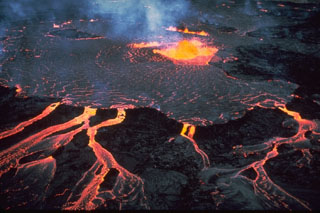Report on Kilauea (United States) — 26 February-4 March 2025
Smithsonian Institution / US Geological Survey
Weekly Volcanic Activity Report, 26 February-4 March 2025
Managing Editor: Sally Sennert.
Please cite this report as:
Global Volcanism Program, 2025. Report on Kilauea (United States) (Sennert, S, ed.). Weekly Volcanic Activity Report, 26 February-4 March 2025. Smithsonian Institution and US Geological Survey.
Kilauea
United States
19.421°N, 155.287°W; summit elev. 1222 m
All times are local (unless otherwise noted)
The Hawaiian Volcano Observatory (HVO) reported that the eruption within Kilauea’s Kaluapele summit caldera, from vents along the SW margin of Halema’uma’u Crater, continued at variable levels during 26 February-4 March. The eleventh episode of lava fountaining occurred over an almost 13-hour period during 25-26 February. The episode was preceded by the appearance of incandescence from the row of vents along a fissure on the E side of the crater formed during September 2023. The incandescence began at one cone on the evening of 24 February and became visible along the entire fissure around 1800 on 25 February. The N vent began erupting at 1822 with low lava fountains, followed by small spattering fountains at the S vent just before 1900. Incandescence along the fissure persisted through much of the night, suggesting that magma may have intruded into the molten interior of Halema’uma’u Crater prior to the onset of the episode. Lava fountaining from the N and S vents ceased by 0706 on 26 February. Lava covered approximately 75-80 percent of the crater floor and flowed onto the down-dropped block, around the September 2023 vents. A large amount of pumice, Pele?s hair, and lightweight reticulite blanketed the W rim of Halema’uma’u Crater, and a few lightweight "ribbon" bombs up to about 0.6 m in diameter were deposited on top of the pumice.
On 26 February fresh lava in the NE corner of the crater floor appeared to have been emplaced from beneath the crater floor rather than from the recent flows. That flow and several other small flows were related to the incandescence along the September 2023 fissure. Overnight during 26-27 February a large section of the lava-flow crust overturned in the middle of the crater floor and a few small lava breakouts occurred from the flow front in the SE corner of the crater floor. During 28 February-3 March flows S of the September 2023 vents were active. The flows at the NE part of the crater floor began to stagnate, with only spots of incandescence visible during 1-3 March. Incandescence at both the N and S vents was variable through 3 March. Small domed fountains less than 5 m high erupted from the S vent during 0730-0740 on 4 March, producing a slow-moving lava flow that advanced onto the crater floor. Small fountains at the N vent began at 0804; during 0933-0945 lava overflowed the vent. The S vent produced small fountains and an active lava flow during 1245-1400. Lava fountains began again at the N vent at around 1400 that rose 5-10 m, and by 1420 they were reaching 50 m. The Volcano Alert Level remained at Watch (the third level on a four-level scale) and the Aviation Color Code remained at Orange (the third color on a four-color scale).
Geological Summary. Kilauea overlaps the E flank of the massive Mauna Loa shield volcano in the island of Hawaii. Eruptions are prominent in Polynesian legends; written documentation since 1820 records frequent summit and flank lava flow eruptions interspersed with periods of long-term lava lake activity at Halemaumau crater in the summit caldera until 1924. The 3 x 5 km caldera was formed in several stages about 1,500 years ago and during the 18th century; eruptions have also originated from the lengthy East and Southwest rift zones, which extend to the ocean in both directions. About 90% of the surface of the basaltic shield volcano is formed of lava flows less than about 1,100 years old; 70% of the surface is younger than 600 years. The long-term eruption from the East rift zone between 1983 and 2018 produced lava flows covering more than 100 km2, destroyed hundreds of houses, and added new coastline.
Source: US Geological Survey Hawaiian Volcano Observatory (HVO)

